When I first moved to Dubai, I was looking forward to exploring the desert and its exotic creatures. But when I realised that there was a lack of information about dolphins and whales in the Gulf, I thought that if I was able to contribute to something in the UAE, it should be about what I know best: wild dolphins.
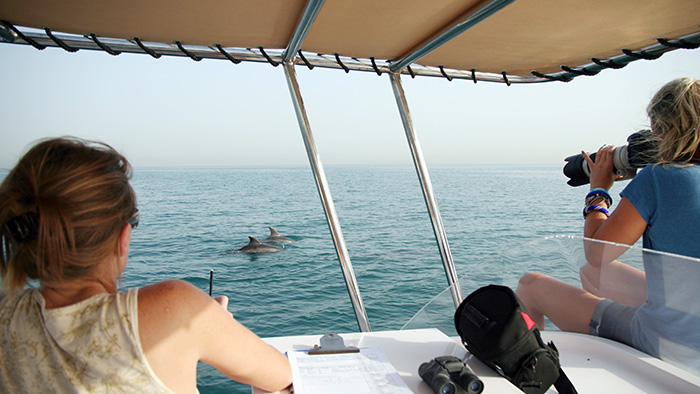
It still astonishes me how little we, both scientists and people in general, know about the ocean and its life. Despite advances in research and awareness,our knowledge just scrapes the surface of the blue world. Indeed, water is not our natural media and unless we really put effort into it, life in the ocean can really pass by unnoticed. I still clearly remember, during one of the research boat surveys I was participating in, this 18 meters long whale surfacing just beside a leisure sailing boat and its passengers sunbathing on the deck, totally unaware: they simply didn’t see it!
Dolphins in the UAE follow a similar fate. People do not even consider the remote possibility to see dolphins in Dubai or Abu Dhabi, except in dolphinariums. Instead, wild dolphins live on our doorsteps, many times visible from busy coastlines such as Palm Jumeirah in Dubai or Saadiyat Island in Abu Dhabi. What we know about them, including how many there are out there, which species, if they are in decline or not, is close to nothing.
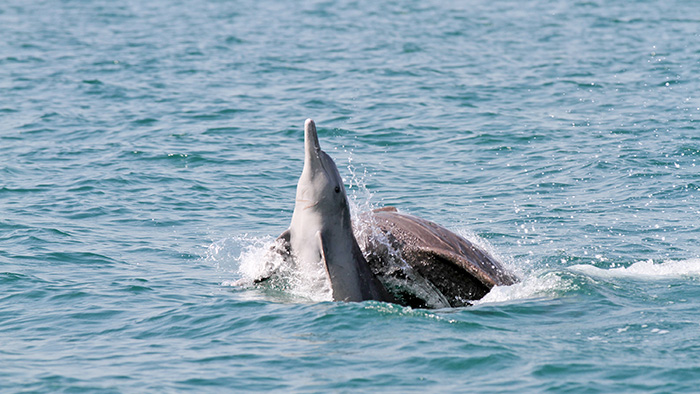
Origins
Whales and dolphins are simply amazing creatures, an example of ultimate adaptation to a totally unsuitable environment. Just think how hard it is for us to stay totally in water for more than few hours! Like humans, they in fact descend from terrestrial mammals that about 50 million years ago decided to colonise the water environment. They breathe air, they are warm-blooded creatures like us and to be able to spend their whole life in water, they had to undertake massive adaptation. The posterior limbs withdrew, leaving space for a powerful tail that functions as a propeller. A thick layer of fat developed under their skin, creating a natural insulator to keep the body temperature constant (and this is what the whalers for centuries were after, bringing some populations to the brink of extinction). Hairs and external appendixes disappeared,creating a sleek and smooth skin to minimize friction;the nose became a blowhole migrating to the nape and allowing swimming and breathing at the same time,and ears became only internal. They optimised their underwater sight and mastered the utilisation of sound to communicate across oceans and to echolocate their preys even in the abyss. They perfected free diving techniques – some species of whales can spend over two hours underwater reaching depths of 2,000 metres.
Today have counted about 90 different species of whales and dolphins, four of those inhabiting fresh waters, but fossil remains proved the existence of about 593 different species that roamed our oceans in the past.
Whales and dolphins are extremely social animals that rely on the group to feed, defend themselves, migrate and reproduce. Long-term bonds among individuals are common; aside from mother and calf pairs, “best friends” are frequently seen together and deaths are mourned.
Thanks to latest research, today we know that a whale’s sound can be heard from one side of the ocean to the other, and that is how whales can find each other again after their periodical migration from the cold feeding grounds at the poles to the breeding grounds at the equator. We know that different populations have different dialects, and long-term studies on resident dolphin populations revealed that individual dolphins call each other specific names as we do.
Still, in many areas and for many species of dolphins and whales information is limited and new species are continuously discovered. Unfortunately some also disappear; the bajii was a type of dolphin inhabiting the Yangtze River and it is the first mammal species declared extinct in modern times (2006). Today there are some species of dolphins and populations of whales, like the Vaquita in Baja California, Mexico, and the Arabian Humpback Whale in the Northern Indian Ocean, Oman, that are on the brink of extinction with less than 100 individuals left.

Our work
To protect a species there are few crucial steps that need to be taken. We need to know which species it is,people need to know about its existence, its importance in the environment and what they can do to help its survival. The authorities also have to be informed with sound scientific data in order to be able to implement effective conservation actions.
When I started looking at information about dolphins in the UAE, the only data available was from two aerial surveys conducted in 1986 and 1999 in the Abu Dhabi region. Comparing the numbers of the surveys, researchers estimate a 71% decline in dolphin sightings. Other information regarding the species’ presence came from a mass stranding that happened in Iran in 2007 and a survey across the Gulf in 1994. Not very much at all! However, from a questionnaire run in 2012, the majority of the sea users interviewed in Dubai said that they “encounter dolphins occasionally”, but interestingly most of the sightings were within 5 miles from shore and occurred recently; an indication that dolphins were still present in these waters.
The UAE dolphin project initiative was born to investigate the status of the dolphin population inhabiting along the UAE coastline with the target of providing the national and international bodies with useful information to assist the formulation of conservation plans to protect them and to raise public awareness about the existence of these species.
It may sound easy to say but this implies a monumental effort, especially when people do not know that these creatures exist!So, after a year-long campaign trying to convince the authority and potential sponsors to support the quest of studying these elusive dolphins, in 2014 we ran the first year long survey dedicated to coastal dolphins ever conducted in the Gulf.
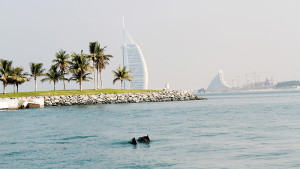
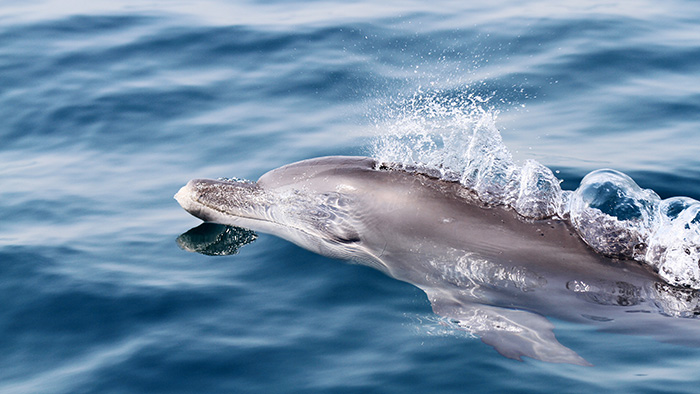
Dubai dolphins
Dubai has its own wild dolphins and if you want to see them, you simply need to keep your eyes open when at sea or at the beach and it will happen. There are actually two species of dolphins and one species of porpoise frequenting Dubai waters: the Indo-Pacific Bottlenose dolphin, the Indo Pacific Humpback dolphin and the shy, finless porpoise.
One of the powerful techniques utilised by researchers is photo-identification. Individual dolphins can be univocally identified by their dorsal fin, which with time usually accumulates indelible notches and marks. Taking pictures of all the individuals at each encounter, researchers can estimate the population size, whether the population is resident and the social structure: who hangs out with who, mother and calf pairs and the survival rate.
After spending over 300 hours at sea, covering about 2,000 miles following transects between Port Rashid and Jebel Ali, the analysis of over 7,300 pictures gave its results.
Throughout the 20 encounters of dolphins, we observed 212 dolphins, but looking at the pictures they are actually much less, as many of them are the same individuals coming back again in the same areas. We now recognise 92 bottlenose dolphins and 23 humpback dolphins that frequent Dubai waters. Humpback dolphins are more resident with a resighting rate of about 40%, with bottlenose dolphins at about 20%. Calves were observed in both species, suggesting that both species breed in the area. We can now follow a number of mother-calfcouples, and in both species we unfortunately witnessed the disappearance of a calf.
Your work
As much as researchers can be skilled, they are at best one boat and a few eyes screening the immense sea. Since the start of the project one of our main targets was to let everyone know that there were dolphins in the UAE and that everyone could actively help the research.We launched a “Report a Sighting” system where everyone who sees dolphins can report their sighting. This data is crucial information as it gives us an idea of hotspot areas for dolphins and potential targets for future investigation.
Thanks to numerous supporters, we reached out to diving centers, marinas, schools, universities and the general public. We know we are still a long way from being able to say that we have reached everyone, but to date we are proud to count over 350 sightings reported by the public in our database. Among these are sightings of rare species like killer whales, false killer whales, Bryde’s whales and strandings. Based on these data, we identified some areas of high frequency for dolphins like the waters outside Emirates Palace and Saadiyat Island in Abu Dhabi and Kite Beach and The Palm Jumeirah in Dubai. Furthermore, since December 2015 and thanks to the support of TDIC and local venues, we have started a land based survey on Saadiyat Island to better investigate the presence of dolphins along that coastline.
Special thanks goes out to everyone who supports us: Dubai Municipality, who provided us with the scientific permit, Duretti Boat Manufacturing, Dubai Marina Yacht Club, Salini-Impregilo, ITP Publishing, Suzuki-Autosport, Superprogetti, all the volunteers that participate in the field work, students from Dubai and Abu Dhabi schools, and everyone that reported sightings and supports our awareness campaign.
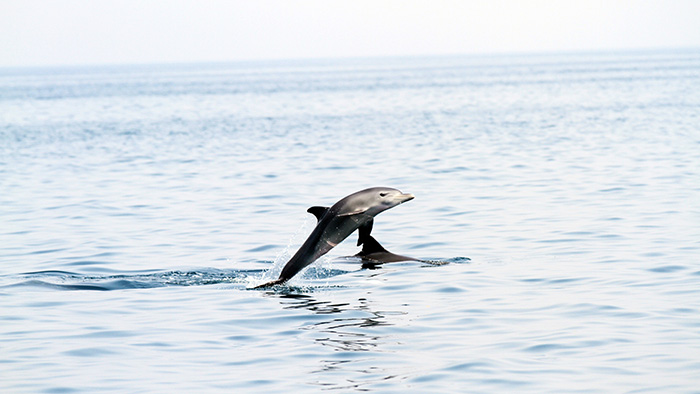
What can you do to help protect dolphins in the UAE
Whenever you are at sea on a boat or on land, keep an eye on the water, and if you see dolphins REPORT YOUR SIGHTING!
Your information is invaluable to researchers and will help them to further understand the occurrence and distribution of these creatures.
Simply take note of the date, time and approximate location. If you can, identify the species and take a picture. You may help us to track one of the dolphins we have already met. If you can, take note of the approximate number and check for the presence of calves.
You can report your sightings through the project website www.uaedolphinproject.org, or through the projects Facebook, Twitter or Instagram accounts.
Words + Photos by: Dr. Ada Natoli
Dr. Ada Natoli has been conducting research on whales and dolphins for the past 20 years in different areas of the world. She is part of the IUCN Cetaceans Specialist list and is involved in the International Whaling Commission as well as collaborating with a number of International Universities.She has extensive experience in field-work and specialised in population genetics applied to conservation. She gained a PhD in Molecular Ecology of two species of dolphins, bottlenose and common dolphins, investigating their population structure world-wide and in specific areas like the Mediterranean Sea, South Africa and New Zealand. Her results have contributed to support the formulation of conservation measures of these species in different countries.

